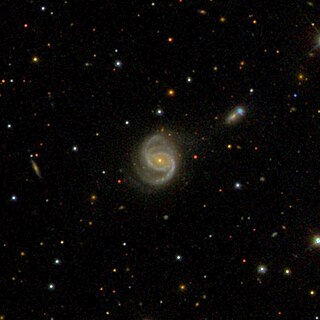
IC 1337 is an intermediate spiral galaxy in the constellation Capricornus. The galaxy is located close to the celestial equator. It was discovered by Stéphane Javelle on July 22, 1892.
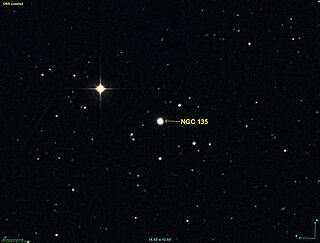
NGC 135 is a lenticular galaxy located in the constellation of Cetus and 335 million light-years away and is 40,000 light-years across.

IC 3 is a compact elliptical galaxy located approximately 228 million light-years away in the constellation of Pisces. The galaxy was discovered by astronomer Stéphane Javelle on August 27, 1892.

NGC 499, also occasionally referred to as PGC 5060, IC 1686 or GC 289, is a lenticular galaxy in the constellation Pisces. It is located approximately 197 million light-years from the Solar System and was discovered on 12 September, 1784 by astronomer William Herschel.

NGC 575 is a barred spiral galaxy of Hubble type SB(rs)c in the constellation Pisces. It is approximately 145 million light years from the Milky Way and has a diameter of about 70,000 light years.

IC 4271 is a spiral galaxy located some 800 million light-years away in the Canes Venatici constellation. It is 130,000 light-years in diameter. IC 4271 was first located on July 10, 1896, by Stephane Javelle, a French astronomer. It hosts a Seyfert type 2 nucleus, containing an acceleration disc around its supermassive black hole which releases large amounts of radiation, hence its bright appearance. IC 4271 appears to be interacting with its smaller neighboring galaxy, PGC 3096774.
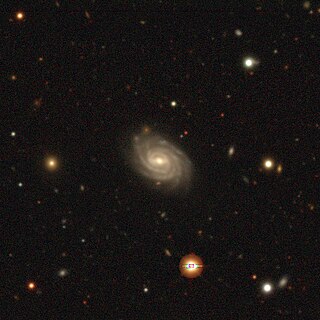
IC 42 known as PGC 2463 and PGC 911417, is a barred spiral galaxy located in the constellation of Cetus. It is about 750 million light-years away from the solar system and has an estimated diameter of 145,000 light-years, making it bigger compared to the Milky Way galaxy. It was first found by Stephane Javelle, a French astronomer on August 25, 1892. According to SIMBAD, it is considered as an emission-line galaxy.
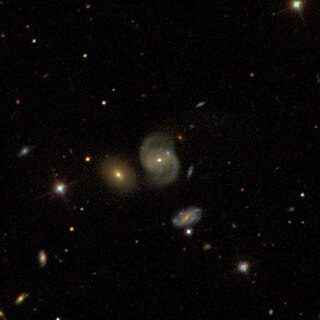
IC 4461 is a spiral galaxy located in the Boötes constellation, located at distance of 417 million light-years from both the Milky Way and Andromeda Galaxy.

IC 64 is a massive lenticular galaxy located 622 million light-years away in the Pisces constellation. IC 64 has a diameter of 300,000 thousand light-years, making it, three times bigger than the Milky Way and one of the largest galaxies observed. IC 64 was discovered by Stephane Javelle, a French astronomer on 5th December, 1893. It has an active galactic nucleus and is considered a radio galaxy.

IC 158 is an elliptical galaxy in the constellation of Cetus. The galaxy was discovered on December 14, 1892, by French astronomer, Stephane Javelle. According to Javelle, when he first saw the object, he described it as faint, small and round with a brighter middle. It has an approximate diameter of 200,000 light-years making it larger compared to the Milky Way. IC 158 is located 700 million light-years away from the Solar System and is moving away at the speed of 15,678 kilometers per second.

IC 5337 or JW100, is a spiral galaxy located 800 million light-years away from the Solar System in the constellation of Pegasus. It is probably gravitationally bound to IC 5338, the brightest cluster galaxy in Abell 2626. IC 5337 is a jellyfish galaxy, mainly due to dynamic stripping pressure. Star-forming gas are thrown about, as the galaxy penetrates through the thin gas layer and causing them to drip from the galaxy's disc, giving it its unique appearance of a cosmic jellyfish. In the image, other galaxies can be seen in the background.

NGC 5008 is a massive barred spiral galaxy located in the Boötes constellation.

IC 535 known as PGC 26524 and PGC 1128295, is a type E elliptical galaxy with a ring located in the Hydra constellation. It is located 740 million light-years away from the Solar System and has an estimated diameter of 85,000 light-years. IC 535 was discovered on March 23, 1893, by Stephane Javelle. It has a surface brightness of 23.7 mag/arcsec and is moving at radial velocity of 16,049 kilometers per seconds. It is located at right ascension and declination.
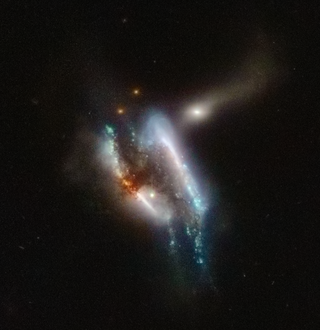
IC 2431 are a group of interacting galaxies in the constellation of Cancer. They are located 684 million light-years away from the Solar System and were discovered on February 24, 1896, by Stephane Javelle.

IC 1166 are a pair of galaxies in the Corona Borealis constellation comprising IC 1166 NED01 and IC 1166 NED02. They are located 977 million light-years from the Solar System and were discovered on July 28, 1892, by Stephane Javelle.
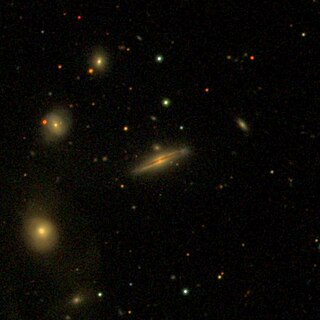
IC 1192 is an edge-on barred spiral galaxy located in Hercules. It is located 543 million light-years from the Solar System and has a diameter of approximately 90,000 light-years. IC 1192 was discovered by Stephane Javelle on August 13, 1892. It is a member of the Hercules Cluster.

IC 2498 known as PGC 27668, is a type Sb barred spiral galaxy located in constellation Leo. It is located 469 million light-years away from the Solar System and was discovered by Stephane Javelle on April 30, 1896.
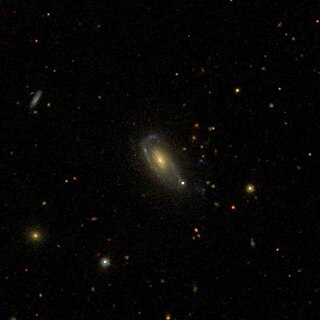
IC 1050 is a type Sbc spiral galaxy located in constellation Boötes. It is located 491 million light-years from the Solar System and has an approximate diameter of 130,000 light-years. IC 1050 was discovered by Stephane Javelle on June 3, 1892.

IC 848 is a type Sbc barred spiral galaxy located in Coma Berenices. Its redshift is 0.053077 which corresponds the galaxy to be located 727 million light-years away from Earth. IC 848 has an apparent dimension of 0.80 x 0.6 arcmin, meaning it is about 170,000 light-years across. It was discovered by Stephane Javelle on July 22, 1892, which was described per Dreyer as "extremely faint, very small and difficult".

IC 4539 is a type SABb intermediate spiral galaxy located in Corona Borealis. Its redshift is 0.061307, which corresponds IC 4539 to be 845 million light-years from Earth. It has an apparent dimension of 0.40 x 0.4 arcmin, meaning the galaxy is about 95,000 light-years across. IC 4539 was discovered by Stephane Javelle on June 23, 1903, who found it "as faint, small, round with a very brighter middle."




















